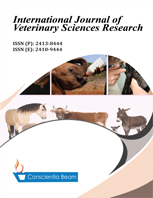Prevalence of Subclinical Mastitis and its Effects on Reproductive Performance in Dairy Cows during the Postpartum Period in Gasabo District, Rwanda
DOI:
https://doi.org/10.18488/journal.110.2021.61.1.13Abstract
Mastitis is one of the most important diseases affecting production and reproductive efficiency of dairy cows. The objective of this study was to estimate the prevalence of subclinical mastitis (SCMA) and its effects on reproductive performance in postpartum dairy cows. In a cross-sectional survey, sample cows (n = 200) within their 10-40 days in milk from smallholder farms (n = 159) were selected and tested for SCMA using California Mastitis Test. They were classified into two groups: cows with SCMA (SCMA group, n = 101) and cows without SCMA (WSCMA group, n = 99). Reproductive performance including calving-to-first-oestrus interval (CFOI), calving-to-first service interval (CFSI), calving-to-conception interval (CCI), cows that remained non-pregnant, postpartum anoestrus, and total number of services per conception were recorded for 150 days in milk. The overall prevalence of SCMA recorded was 50.5%. The mean number of days for CFOI was significantly longer (p<0.05) in cows with SCMA (87.6±4.8 days) than in cows WSCMA (72.5±4.3 days). The mean days for CFSI was significantly longer (p<0.05) in cows with SCMA (97.2±5.6 days) than in cows WSCMA (78.9±4.9 days). The difference between the CCI of the SCMA positive cows (107.8±7.4 days) and that of the negative ones (62.5±4.5 days) was statistically significant (p<0.001). Cows with SCMA required more breeding services (p<0.05) to conceive (1.9±0.1 services) than cows WSCMA (1.2±0.1 services). Results indicate that SCMA had significant negative effect on fertility performance. Therefore, improving management interventions to prevent and control SCMA is essential for reducing its adverse effects in dairy cows.

